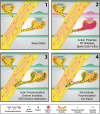Of microtubules and memory: implications for microtubule dynamics in dendrites and spines
- PMID: 28035040
- PMCID: PMC5221613
- DOI: 10.1091/mbc.E15-11-0769
Of microtubules and memory: implications for microtubule dynamics in dendrites and spines
Abstract
Microtubules (MTs) are cytoskeletal polymers composed of repeating subunits of tubulin that are ubiquitously expressed in eukaryotic cells. They undergo a stochastic process of polymerization and depolymerization from their plus ends termed dynamic instability. MT dynamics is an ongoing process in all cell types and has been the target for the development of several useful anticancer drugs, which compromise rapidly dividing cells. Recent studies also suggest that MT dynamics may be particularly important in neurons, which develop a highly polarized morphology, consisting of a single axon and multiple dendrites that persist throughout adulthood. MTs are especially dynamic in dendrites and have recently been shown to polymerize directly into dendritic spines, the postsynaptic compartment of excitatory neurons in the CNS. These transient polymerization events into dendritic spines have been demonstrated to play important roles in synaptic plasticity in cultured neurons. Recent studies also suggest that MT dynamics in the adult brain function in the essential process of learning and memory and may be compromised in degenerative diseases, such as Alzheimer's disease. This raises the possibility of targeting MT dynamics in the design of new therapeutic agents.
© 2017 Dent. This article is distributed by The American Society for Cell Biology under license from the author(s). Two months after publication it is available to the public under an Attribution–Noncommercial–Share Alike 3.0 Unported Creative Commons License (http://creativecommons.org/licenses/by-nc-sa/3.0).
Figures




References
-
- Akhmanova A, Steinmetz MO. Control of microtubule organization and dynamics: two ends in the limelight. Nat Rev Mol Cell Biol. 2015;16:711–726. - PubMed
-
- Andrieux A, Salin P, Schweitzer A, Begou M, Pachoud B, Brun P, Gory-Faure S, Kujala P, Suaud-Chagny MF, Hofle G, Job D. Microtubule stabilizer ameliorates synaptic function and behavior in a mouse model for schizophrenia. Biol Psychiatry. 2006;60:1224–1230. - PubMed
Publication types
MeSH terms
Substances
Grants and funding
LinkOut - more resources
Full Text Sources
Other Literature Sources
Medical

